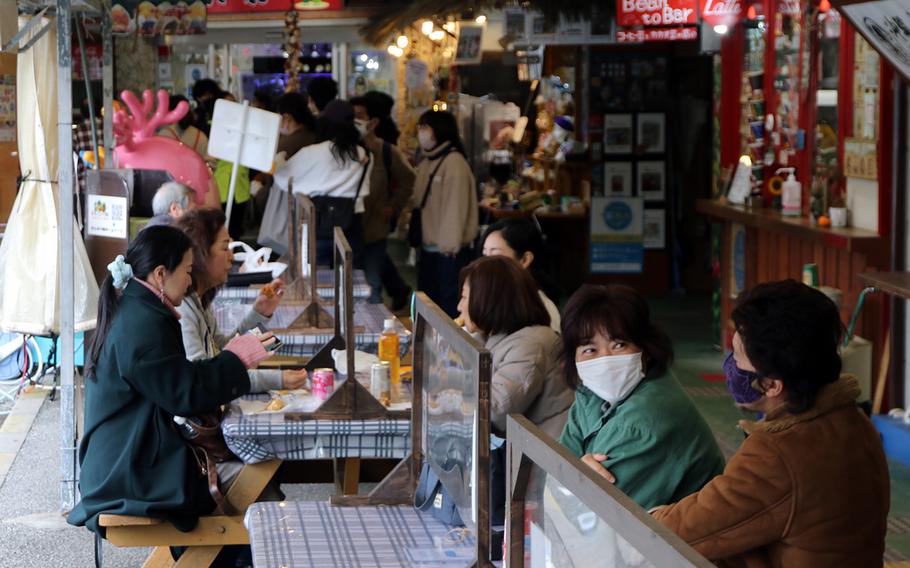
Onna no Eki Nakayukui Market, whose name translates roughly to Roadside Station, is an amalgamation of restaurants and vendors hawking every Okinawan souvenir. (Matthew M. Burke/Stars and Stripes)
A bazaar in Onna village offers the very best of Okinawa in one convenient location.
Onna no Eki Nakayukui Market, whose name translates roughly to “Roadside Station,” is an amalgamation of restaurants and vendors hawking every island souvenir, including sea grapes, moringa and shisa dog underwear.
The market also has 10 stalls serving up fresh Okinawan staples like doughnuts and soba.
Onna no Eki opened primarily as a farmer’s market in 1990. Its fruits and vegetables come from 400 registered farmers, the majority of whom are local to Onna village.
Tropical fruits are seasonal. Tankan mandarin oranges are available in January and February; passion fruit from March to June; mango and pineapple from June to September; dragon fruit from July to November; and bananas from September to October.
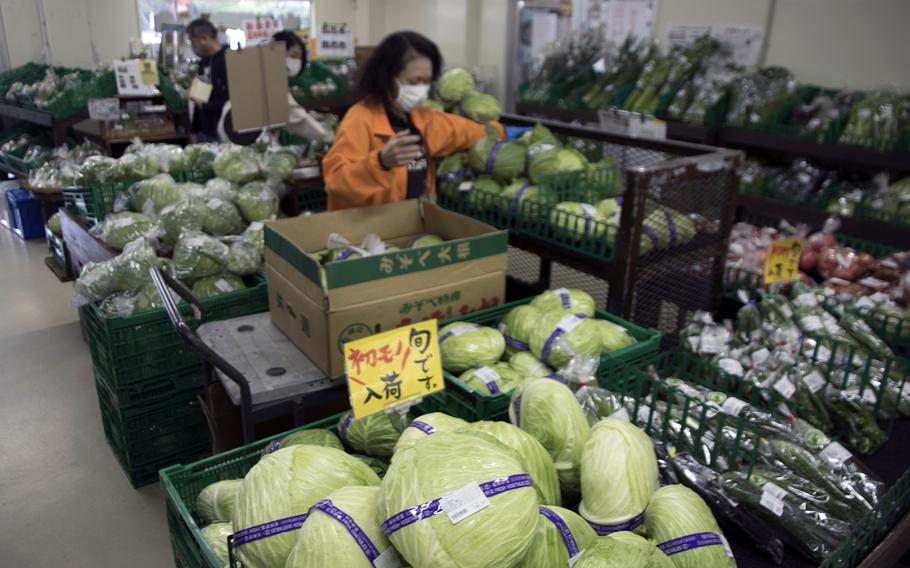
Onna no Eki Nakayukui Market opened primarily as a farmer’s market in 1990. Its fruits and vegetables come from 400 Okinawa farmers, the majority of whom are local to Onna village. (Matthew M. Burke/Stars and Stripes)
Shekwasa, which resembles a lime, is sold from September to December, and papaya is available year-round.
In the winter months, the market sells strawberries from its own farm. The first yield from a new passion fruit endeavor is expected toward year’s end.
Onna no Eki has nearly all of the souvenirs available at Naha Airport and then some. There is chiffon cake, called “the blues,” that comes from the acclaimed Mitsuya honpo company, known locally for its delectable Okinawan doughnuts.
Those doughnuts are like the sweet, plain treats common in the United States, except they are deliberately misshaped to maximize nooks and crevices, which in turn form a crispy outer crust, encapsulating the fluffy cake inside.
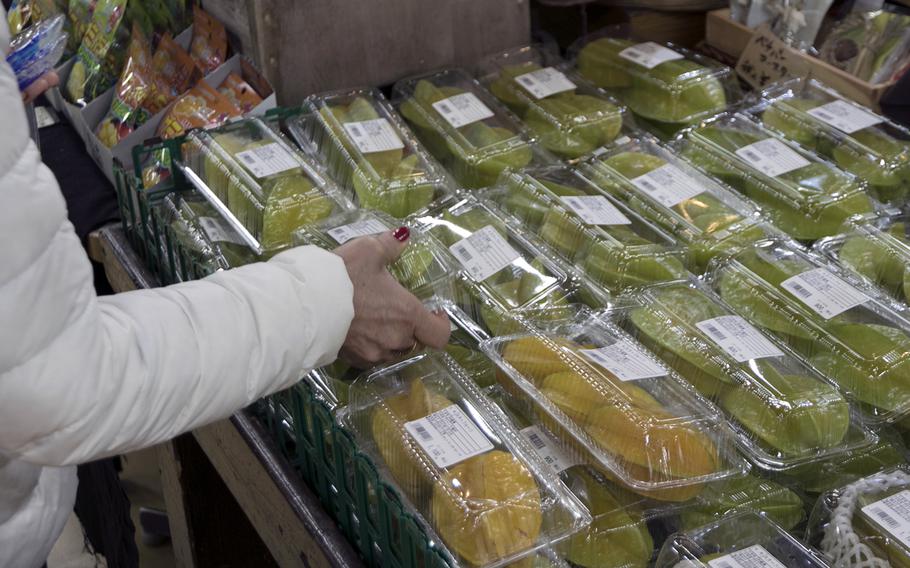
Onna no Eki Nakayukui Market opened primarily as a farmer’s market in 1990. Its fruits and vegetables come from 400 Okinawa farmers, the majority of whom are local to Onna village. (Matthew M. Burke/Stars and Stripes)
The market also sells its own passion fruit liqueur, a tomato curry made by a local farmer and Sango No Umi, awamori from a local distillery.
About a million people visited Onna no Eki last year, according to market manager Chikako Iha.
The market employees are warm, welcoming and helpful, using gestures and translation apps to communicate; most do not speak English.
The market periodically schedules performances in the outdoor food court and special events every three months.
On a sunny day at the end of March, Onna no Eki was buzzing, its outdoor picnic tables filled with tourists slurping down steaming bowls of noodles and broth.
The main market was awash in a flurry of colors and scents, including royal blue Okinawa glass, colorful bags of locally produced sea salt, tarts made with Okinawa’s purple sweet potatoes and rows of atemoya.
A pair of shisa, the dog-like guardians placed at the entrance to Okinawan homes, sell for just under $6.
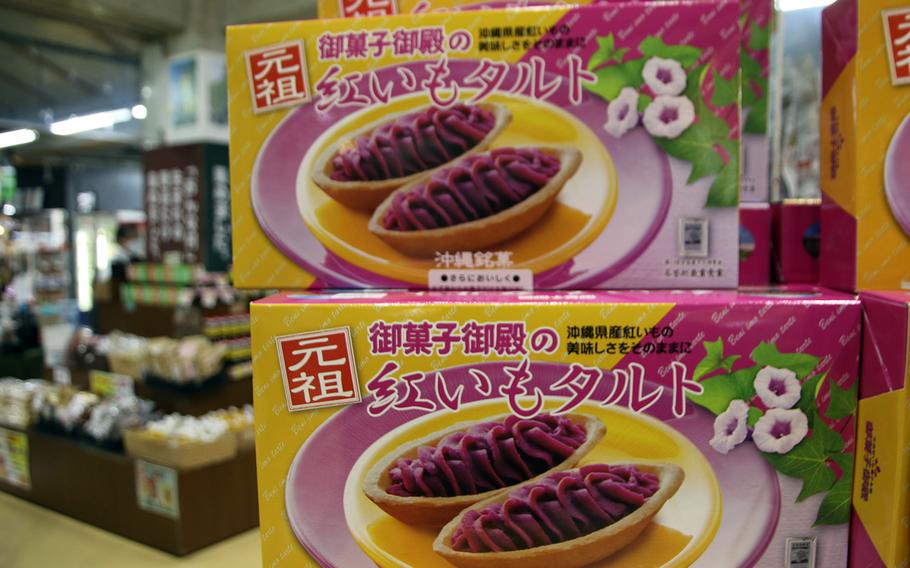
Onna no Eki Nakayukui Market, whose name translates roughly to Roadside Station, is an amalgamation of restaurants and vendors hawking every Okinawan souvenir. (Matthew M. Burke/Stars and Stripes)
A bottle of the local awamori liquor that had been aged at the bottom of the sea sells for 9,800 yen, or about $75. The bottle came with a special cloth to open it so you didn’t cut your hand on a barnacle.
The seller claims pressure at the sea bottom helps quickly mature the liquor inside. There may be something to that; the liquor was sweet and smooth when served with a splash of water on the rocks.
Pickled goya and some Chinsuko sugar cookies finished the shopping trip, which elicited quite an appetite.
Curry Savila, a dining spot just outside the market, serves up a plate of Yanbaru curry, complete with a large pork spare rib, for 1,080 yen. Yanbaru is the name given to Okinawa’s heavily forested north.
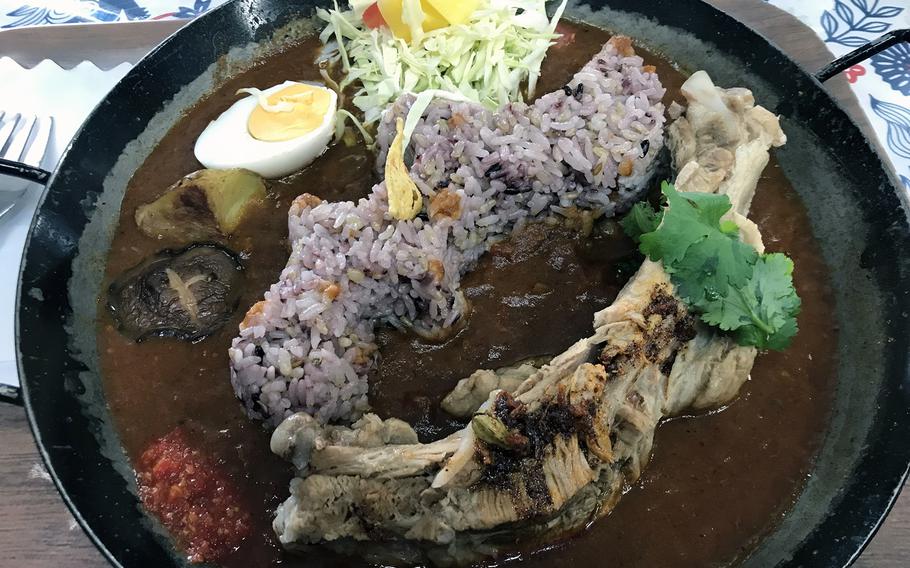
Curry Savila serves up a plate of Yanbaru curry, complete with a large pork spare rib, for 1,080 yen. (Matthew M. Burke/Stars and Stripes)
The brown rice was shaped with a mold into the island of Okinawa and served on a hot skillet with salad. The curry flowed around the rice island like the waters around Okinawa. The presentation was stellar.
The curry was hearty with just the right amount of spice, but the real star of the dish was the rib meat, which fell effortlessly off the bone.
Onna no Eki is Okinawa, commoditized, packaged and sold in all its vibrant and delicious glory.
On the QT
Directions: 1656-9 Nakadomari, Onna, Kunigami District, Okinawa 904-0415, behind the Onna Village Museum, off Route 58 in Onna Village.
Times: Open daily, 10 a.m. to 7 p.m.
Costs: Parking (133 spots) and admission is free. Meals can cost anywhere for a few dollars for a bento or freshly baked bread, to as much as $10 for soba or curry. Cards are accepted.
Food: Onna no Eki features 10 stalls serving up fresh Okinawan staples like doughnuts and soba.
Information: Phone: 0989641188; Online: onnanoeki.com